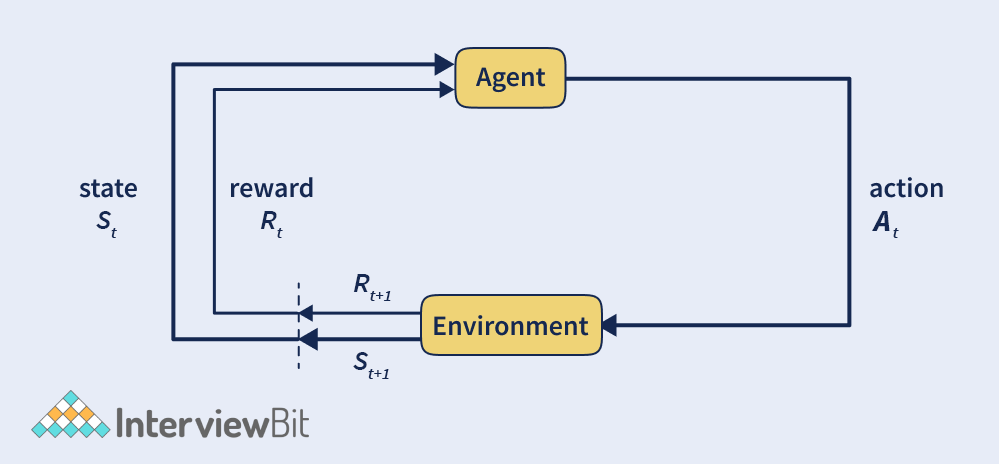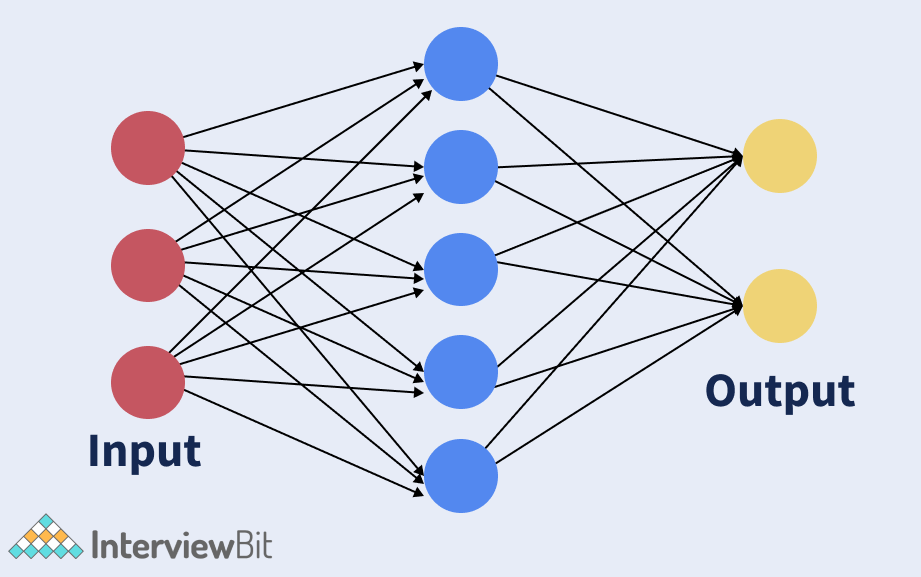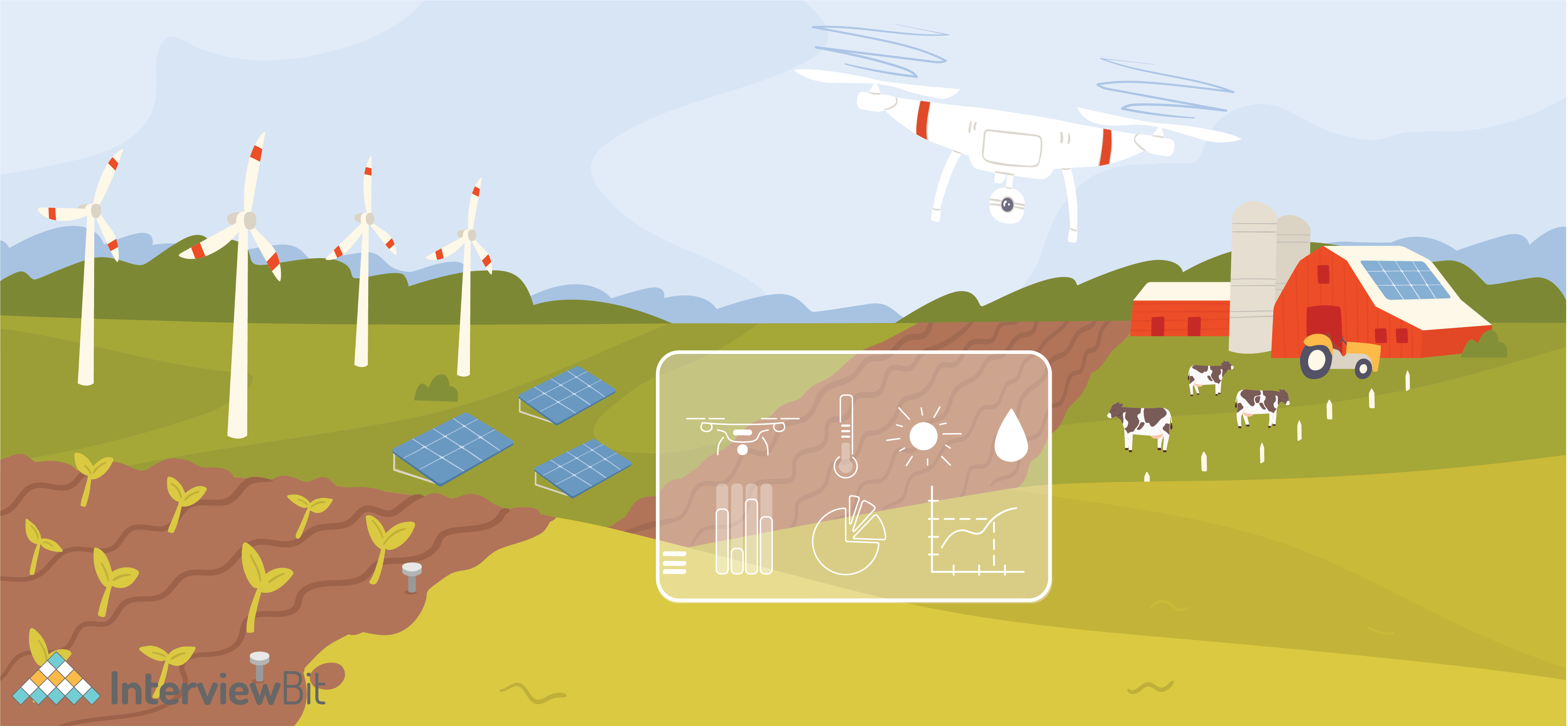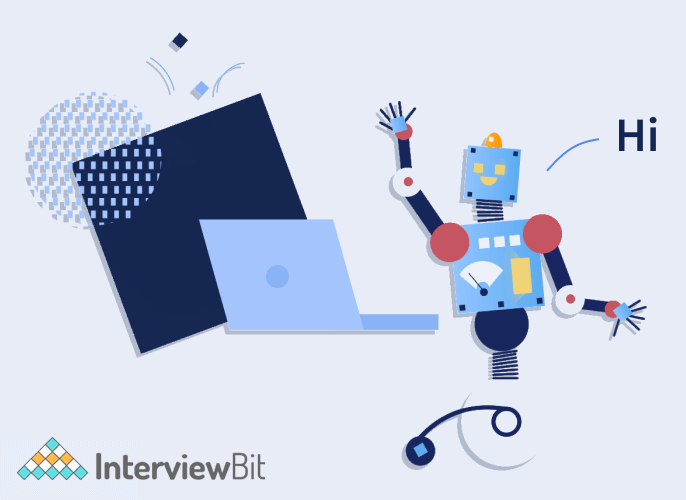14. Which assessment is used to test the intelligence of a machine? Explain it.
The Turing test is used to determine whether or not a machine is capable of thinking like a human. IT was developed by Alan Turing in 1950.
The Turing Test is like an interrogation game between three players. There is an interrogator who is a human. He has to interrogate two other players- one computer and one human. The interrogator has to figure out which one is a computer by asking questions. The computer has to do its best to make itself hard to be distinguished from the human. The machine will be considered intelligent if it makes it hard to be distinguished from the human.
Consider the following scenario: Player A is a computer, Player B is a human, and Player C is a questioner. The interrogator is aware that one of them is a robot, but he needs to figure out which one. Since all players communicate via keyboard and screen, the outcome is unaffected by the machine's capacity to transform words into speech. The exam result is determined not by the number of correct answers, but by how closely the responses resemble those of a human. The computer is permitted to do whatever it can to force the interrogator to make a false identification.
The question-answer session can be like this-
Interrogator: Are you a computer?
Player A (computer)- No.
Interrogator: Multiply two huge numbers, such as (256896489*456725896).
Player A- After a long delay, he gives the incorrect answer.
If an interrogator is unable to distinguish between a machine and a human in this game, the computer passes the test, and the machine is said to be intelligent and capable of thinking like a human. This game is popularly called ‘imitation game’.
15. What is Computer Vision in AI?
Computer Vision in the field of AI enables computer systems to deduce meaningful interpretations from images or any other visual stimulation and take action based on that input. AI gives the system the ability to think, then computer vision gives the system the ability to observe. Computer vision is very much similar to human vision.
Pattern recognition is the foundation of today's computer vision algorithms. We train computers on a vast amount of visual data—images are processed, things are labeled, and patterns are found in those items. For example, if we submit a million photographs of flowers to the computer, it will analyze them, find patterns that are common to all flowers, and produce a model "flower" at the end of the process. As a result, every time we submit them photographs, the computer will be able to precisely recognize whether a certain image is a flower. Computer vision is can be witnessed in many areas of our lives.
18. How many types of agents are there in Artificial Intelligence?
- Simple Reflex Agents: Simple reflex agents ignore the history of the environment and its interaction with the environment and act entirely on the current situation.
- Model-Based Reflex Agents: These models perceive the world according to the predefined models. This model also keeps track of internal conditions, which can be adjusted according to the changes made in the environment.
- Goal-Based Agents: These kinds of agents react according to the goals given to them. Their ultimate aim is to reach that goal. If the agent is provided with multiple-choice, it will select the choice that will make it closer to the goal.
- Utility-based Agents: Sometimes, reaching the desired goal is not enough. You have to make the safest, easiest, and cheapest trip to the goal. Utility-based agents chose actions based on utilities (preferences set) of the choices.
- Learning Agents: These kinds of agents can learn from their experiences.
19. Explain Markov’s decision process.
Markov’s decision process (MDP) is a mathematical approach for reinforcement learning. Markov's decision process (MDP) is a mathematical framework used to solve problems where outcomes are partially random and partly controlled. To solve a complex problem using Markov’s decision process, the following basic things are needed-
- Agent- The agent is an entity that we are going to train. For example, a robot that is going to be trained to assist in cooking is an agent.
- Environment- The surroundings around the agent are called Environment. The kitchen is an environment in the case of the above-mentioned robot.
- State (S)- The current situation of the agent is called the state. So, in the case of the robot, the position where the robot is, the temperature of the robot, its posture, etc. collectively define the state of the robot.
- Action (A)- The robot can move left or right, or it can pass an onion to the chef, these are some of the actions that the agent (robot) can take.
- Policy (𝜋)- The policy is the reasoning behind taking an action.
- Reward (R) -A reward is received by the agent for taking a desirable action.
- Value (V)- The value is the potential future reward that the agent can receive.
The working of Markov’s model can be understood from the following diagram.

In simple words, the agent has to do some action to start from its initial state. While doing so, it receives rewards based on the actions it takes. The policy defines the action it takes, and the reward collected defines the value (V).
20. What do you understand by reward maximization?
Reward maximization is a technique used in Reinforcement learning. Reinforcement learning is a subset of AI algorithms made up of three main components: an environment, agents, and incentives. The agent alters its own and the environment's state by completing actions. The agent is awarded or penalized based on how much their activities affect the goal the agent must attain. Many reinforcement learning challenges begin with the agent having no prior knowledge of the environment and conducting random behaviors. The agent learns to optimize its actions and adopt policies that maximize its reward based on the feedback it receives.
The goal is to maximize the reward and the action of the agent by using optimal policies. This is called reward maximization. Any abilities that are repeatedly requested by the agent's environment must eventually be created in the agent's behavior if it can alter it to improve its cumulative reward. A good reinforcement learning agent could eventually learn perception, language, social intelligence, and other skills while maximizing its reward.
For example- Content organization in Apple Photos, Facial Recognition systems, self-driving cars, augmented reality, etc. use computer vision.
What is the difference between parametric and non-parametric models?
| Parametric model | Non-Parametric model | ||||||||||||||||||||||||||
|---|---|---|---|---|---|---|---|---|---|---|---|---|---|---|---|---|---|---|---|---|---|---|---|---|---|---|---|
| Parametric models fix a number of parameters to build the model in machine learning | The Non-parametric models use a flexible number of parameters to build the model. | ||||||||||||||||||||||||||
| Parametric analysis is to test group means. | A non-parametric analysis is to test medians. | ||||||||||||||||||||||||||
| It is applicable only for variables. | It is applicable for both – Variable and Attribute. | ||||||||||||||||||||||||||
| Parametric methods can be useful in a variety of scenarios, but they function best when the dispersion of each group is varied. | Similarly, Non-Parametric Methods can perform well in a variety of conditions, but their performance is at its best (top) when each group's spread is equal. | ||||||||||||||||||||||||||
| Parametric models hold strong assumptions about the data. | It holds fewer assumptions about data. | ||||||||||||||||||||||||||
| Examples: Naive Bayes model, logical regression, etc. | Example: KNN.23. What do you understand by hyperparameters?Hyperparameters are the parameters that control the entire training process. These variables are adjustable and have a direct impact on how successfully a model trains. They are declared beforehand. Model hyperparameters, which cannot be inferred while fitting the machine to the training set because they refer to the model selection task, and algorithm hyperparameters, which have no effect on the model's performance but affect the speed and quality of the learning process, are two types of hyperparameters. The selection of good hyperparameters is crucial for the training process. Activation function, alpha learning rate, hidden layers, number of epochs, number of branches in a decision tree, etc. are some of the examples of hyperparameters. 24. What is Overfitting?Overfitting is a concept in data science when a data point does not fit against its training model. When the raining model is fed with data, there is a possibility that it might encounter some noise that cannot fit into the statistical model. This happens when the algorithm cannot perform accurately against unseen data.  Overfitting data points- In the above linear model, some points do not fit in. These points are outliers. 25. What are the techniques used to avoid overfitting?If we can detect overfitting at an early stage, it will be very useful for our training model. There are several methods up our sleeves that can be used to avoid overfitting-
26. What is Natural Language Processing?Natural Language Processing (NLP) is a field of Artificial Intelligence, concerned with giving computers the ability to understand and interact in human languages in a way humans can. NLP combines rule-based modeling of human language with statistical, machine learning, and deep learning models. This makes a computer fully understand and comprehend human language in the form of voice or text. Voice-operated GPS systems, speech-to-text systems, customer service chat boxes, etc. use NLP. Natural language processing encompasses a wide range of methods for analyzing human language, including statistical and machine learning techniques, as well as rules-based and algorithmic approaches. Because text- and voice-based data, as well as practical applications, require a diverse set of methodologies. Tokenization and parsing, lemmatization/stemming, part-of-speech tagging, language detection, and semantic link identification are all basic NLP activities. You've probably done these chores manually previously if you ever diagrammed sentences in elementary school. NLP tasks, in general, break down language into smaller, more basic bits and attempt to comprehend the relationships between them. These tasks are used in higher NLP capabilities like- content categorization, topic discovery and modelling, sentiment analysis, speech-to-text, and text-to-speech conversion. 27. What is the difference between Natural language processing and text mining?
28. What is Fuzzy logic?Fuzzy logic (FL) is a method of reasoning in Artificial Intelligence that resembles human reasoning. According to this logic, the outcome can take any values between TRUE and FALSE (digitally, 0, or 1). For example, the outcome can be certainly yes, possibly yes, not sure, possibly no, or certainly no. Conventional logic states that a computer can take input and produce definite output which is True or False, which is equivalent to human YES or NO.  Fuzzy logic: the outcome can take any value between 0 and 1 29. What is the difference between eigenvalues and eigenvectors?
30. What are the different components of an expert system?An expert system is a computer program that simulates the judgement and behavior of a human or an organization with expert knowledge and expertise in a particular field using artificial intelligence (AI) technologies. The expert systems belong to an important domain of Artificial Intelligence, which is used to solve complex problems using extraordinary human intelligence and expertise. The different components used to build an expert system are:
31. What are some differences between classification and regression?Regression and classification are both supervised learning algorithms. Both works on labeled data and are used to predict in machine learning. The difference, however, arises from the manner in which they are used.
32. What is an Artificial Neural Network? What are some commonly used Artificial Neural networks?Artificial Neural networks, simply called Neural networks, are computer systems based on units called nodes or artificial neurons, which resemble the neurons in human brains. Each node can transmit a signal from one node to another.  An Artificial Neural Network A neural network includes several layers, each of which performs a specialized job. As the model's complexity grows, the number of layers grows as well, which is why it's called a multi-layer perceptron. A neural network in its purest form includes three layers: an input layer, a hidden layer, and an output layer. The input layer receives the input signals and passes them on to the next layer, with the output layer delivering the final prediction. These neural networks, like machine learning methods, must be taught with some training data before being used to solve a specific problem. Let's learn more about the perceptron now. An ANN consists of multiple layers including an input layer, an output layer, and hidden layers. Some commonly used ANN are:
33. What is a rational agent, and what is rationality?A rational agent is a person or entity, based on realistic models, that has preferences for advantageous outcomes and will try to achieve them in all scenarios. A rational agent is one who has defined preferences, models uncertainty and acts in such a way that its performance measure is maximized using all available actions. The proper things are stated to be done by a reasonable agent. AI is concerned with the development of rational agents for application in game theory and decision theory in a variety of real-world contexts. The rational action is the most crucial for an AI agent because, in an AI reinforcement learning algorithm, an agent receives a positive reward for each best feasible action and a negative reward for each incorrect action. Rationality is the ability to remain reasonable and just in all possible scenarios. The performance metric of an agent is used to determine its rationality. The following criteria can be used to assess rationality:
34. What Is Game Theory?Game theory is a branch of AI that attempts to define a strategic game with predefined rules and outcomes between two players of equal rationality. Every player is selfish and tries to maximize the reward to be obtained using a particular strategy. All the players abide by certain rules in order to receive a playoff- which is a reward. Therefore, a game can be defined as a set of players, actions, strategies, and a final reward. Game theory and AI are related to each other and complement each other. Game theory is used in AI situations where multiple agents are in an environment trying to achieve a goal. Various games are logical and have a set of pre-decided rules like chess, poker, etc., which can be made available digitally with the help of Artificial Intelligence and Game Theory. Artificial Intelligence Scenario Based Question35. If you are starting a new business, how will you use AI to promote your business?We can use the following techniques to promote our business.
36. Suppose you know a farmer. He tells you that despite working hard in the fields, his crop yield is deteriorating. How can AI help him?AI can assist Farmers in the following ways:  Artificial Intelligence in Farming
37. “Customers who bought this also bought this”, you might have seen this when shopping on Amazon. How do you think this works?E-commerce giant Amazon uses a concept called collaborative filtering to achieve this. Collaborative filtering is a process of comparing the users with similar shopping behavior in order to suggest products to other users with similar shopping behavior. The engine makes predictions of what might interest a user based on the preferences of other users, and all it has is data. The data it contains include users browsing history, recently ordered products, wishlisted products, etc. For example, a sales record shows that a certain number of people who buy a phone also buy tempered glass along with them. So if next time a user buys a smartphone, he will receive a recommendation to buy a tempered glass as well.  38. What is a Chatbot? How can they help to deliver the best customer support to the customers?A chatbot is a computer program that simulates and processes human conversations. They can interact with us just like any other real person. Chatbots can be a basic program that answers a query in a single line or can be sophisticated assistants that can learn and evolve to attain an increasing level of personalization as they gather and process information. Chatbots have now developed to a level where they can chat with a person without giving the impression that they are talking to a robot. They can work continuously 24*7 even when the customer support executives of organizations are not around. Furthermore, they can harness the power of data and can properly address the grievances of the customer. Therefore, chatbots can be deployed to deliver the best customer support and can decrease the cost of customer service of an organization considerably.  39. Suppose you have to explain to a beginner how a face detection system works. How would you do that?Facial recognition is a technology capable of recognizing a person based on his face. In simple terms, a facial recognition algorithm works in the following ways:
 ConclusionArtificial Intelligence is the new trending guy in town with a bright future. AI influences many spheres of our lives and will continue to drive change in the computing world. I sincerely hope that this article answers the questions you were looking for. |

Comments
Post a Comment